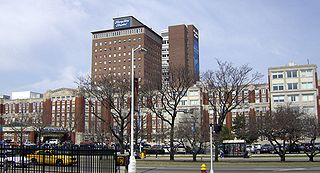
The State University of New York at Buffalo, commonly called the University at Buffalo (UB) and sometimes called SUNY Buffalo, is a public research university with campuses in Buffalo and Amherst, New York, United States. The university was founded in 1846 as a private medical college and merged with the State University of New York system in 1962. It is one of the two flagship institutions of the SUNY system. As of fall 2020, the university enrolled 32,347 students in 13 schools and colleges, making it the largest public university in the state of New York.

Dartmouth–Hitchcock Medical Center (DHMC), the flagship campus of the Dartmouth Health system, is the U.S. state of New Hampshire's only academic medical center. DHMC is a 486-inpatient bed hospital and serves as a major tertiary-care referral site for patients throughout northern New England. As an academic medical center, DHMC offers primary, specialty and subspecialty care as well as education and research in partnership with the Geisel School of Medicine at Dartmouth, one of America's oldest medical schools, as well as the Thayer School of Engineering at Dartmouth and The Dartmouth Institute for Health Policy & Clinical Practice.

The Buffalo Niagara Medical Campus (BNMC) is a medical center of health care, life sciences research and medical education institutions, co-located on 120 acres (49 ha) in Buffalo, New York. The BNMC was founded in 2001 by a consortium. This project comprises one of the five "Strategic Investment Areas" that make up Buffalo, NY's Queen City Hub Plan, the city's strategic plan for urban redevelopment.

Maine Medical Center is a 700-licensed-bed teaching hospital in Portland, Maine, United States. Affiliated with Tufts University School of Medicine, it is located in the Western Promenade neighborhood. It has a staff of over 9,500. The facility is one of only three Level I Trauma Centers in Northern New England. Founded in 1874, it is the largest hospital in northern New England with 28,000 inpatient visits, about 500,000 outpatient visits, 88,000 emergency visits, and over 27,000 surgeries performed annually. MMC is structured as a non-profit, private corporation governed by volunteer trustees. Maine Medical Center is wholly owned by, and serves as the flagship hospital for, MaineHealth, a non-profit healthcare network servicing Maine and New Hampshire.

Henry Ford Hospital (HFH) is an 877-bed tertiary care hospital, education and research complex at the western edge of the New Center area in Detroit, Michigan. The flagship facility for the Henry Ford Health System, it was one of the first hospitals in the United States to use a standard fee schedule and favor private or semi-private rooms over large wards. It was the first hospital in the country to form a closed, salaried medical staff. As founder Henry Ford viewed tobacco as being unhealthy, the hospital was one of the first in the United States to institute a total ban on smoking. Henry Ford Hospital is staffed by the Henry Ford Medical Group, one of the nation's largest and oldest group practices with 1,200 physicians in more than 40 specialties.

UC Davis Medical Center (UCDMC) is part of UC Davis Health and a major academic health center located in Sacramento, California. It is owned and operated by the University of California as part of its University of California, Davis campus. The medical center sits on a 142-acre (57 ha) campus (often referred to as the Sacramento Campus to distinguish it from the main campus in nearby Davis) located between the Elmhurst, Tahoe Park, and Oak Park residential neighborhoods. The site incorporates the land and some of the buildings of the former Sacramento Medical Center (which was acquired from the County of Sacramento in 1973) as well as much of the land (and two buildings) previously occupied by the California State Fair until its 1967 move to a new location.
UC San Diego Health is the academic health system of the University of California, San Diego in San Diego, California. It is the only academic health system serving San Diego and has one of only two adult Level I trauma centers in the region. In operation since 1966, it comprises UC San Diego Medical Center in Hillcrest as well as Jacobs Medical Center, Moores Cancer Center, Shiley Eye Institute, Sulpizio Cardiovascular Center, and Koman Family Outpatient Pavilion, all located in La Jolla. It also includes several outpatient sites located throughout San Diego County. The health system works closely with the university's School of Medicine and Skaggs School of Pharmacy to provide training to medical and pharmacy students and advanced clinical care to patients.
Translational medicine develops the clinical practice applications of the basic science aspects of the biomedical sciences; that is, it translates basic science to applied science in medical practice. It is defined by the European Society for Translational Medicine as "an interdisciplinary branch of the biomedical field supported by three main pillars: benchside, bedside, and community". The goal of translational medicine is to combine disciplines, resources, expertise, and techniques within these pillars to promote enhancements in prevention, diagnosis, and therapies. Accordingly, translational medicine is a highly interdisciplinary field, the primary goal of which is to coalesce assets of various natures within the individual pillars in order to improve the global healthcare system significantly.
The Kolling Institute is located in the grounds of the Royal North Shore Hospital in St Leonards, Sydney Australia. The institute, founded in 1920, is the oldest medical research institute in New South Wales.
Wake Forest University School of Medicine is the medical school of Wake Forest University, with two campuses located in Winston-Salem, North Carolina and Charlotte, North Carolina, United States. It is affiliated with Atrium Health Wake Forest Baptist, the academic medical center whose clinical arm is Atrium Health Wake Forest Baptist. In 2021, U.S. News & World Report ranked Wake Forest School of Medicine 48th best for research in the nation and 80th best for primary care. The School of Medicine also ranks in the top third of U.S. medical schools in funding from the National Institutes of Health (NIH).
The Hauptman-Woodward Medical Research Institute (HWI) is an independent, not-for-profit, biomedical research facility located in the Buffalo Niagara Medical Campus affiliated with the University at Buffalo. Its focus is on structural biology with a strong history in methods development and the application of X-ray crystallography in fundamental studies.

The Lewis Katz School of Medicine at Temple University (LKSOM), located on the Health Science Campus of Temple University in Philadelphia, Pennsylvania. It is one of seven schools of medicine in Pennsylvania that confers the Doctor of Medicine degree. It also confers Ph.D and M.S. degrees in biomedical science, and offers a Narrative Medicine program.

University of South Florida Morsani College of Medicine is one of the graduate schools of the University of South Florida.

Kaleida Health, founded in 1998, is a not-for-profit healthcare network that manages five hospitals in the Buffalo–Niagara Falls metropolitan area. Prior to the merger of member hospitals into the network, it was known as the Millard Fillmore Health System.

Prior Hall, originally known as the Health Sciences Library, is the home of the medical library at Ohio State University. The library was named the John A. Prior Health Sciences Library in 1988 and later renamed to Health Sciences Library in Prior Hall.

University at Buffalo School of Medicine and Biomedical Sciences, also known as Jacobs School of Medicine and Biomedical Sciences, is a public medical school in the city of Buffalo, New York, at the University at Buffalo. Founded in 1846, it is one of the oldest medical schools in the United States and is the only medical school in Buffalo. It is part of the State University of New York (SUNY) system.

The Buffalo area economy consists of a mix of industrial, light manufacturing, high technology, and service-oriented private sector companies. Instead of relying on a single industry or sector for its economic future, the region has taken a diversified approach that has the potential to create opportunities for growth and expansion in the 21st century.
CannonDesign is a global architecture, engineering and consulting practice that provides services for a range of project types, including hospitals and medical centers, corporate headquarters and commercial office buildings, higher education and PK-12 education facilities, hotels and hospitality, mixed-use, sports facilities, and science and research buildings. Brad Lukanic has been the CEO of the employee-owned firm since 2015. In 2017 and 2019, Fast Company named CannonDesign one of the 10 most innovative architecture firms in the world.

The UC San Diego Medical Center, Hillcrest is one of two medical centers of UC San Diego Health and is a teaching hospital for the University of California San Diego School of Medicine.

John R. Oishei Children's Hospital (OCH), sometimes known as simply Oishei Children's is a women's and children's hospital in Buffalo, New York, that opened on November 10, 2017, and provides pediatric specialties and subspecialties to infants, children, teens, and young adults up to age 21, and maternity services for expectant mothers. It is located at the Buffalo Niagara Medical Campus and has 185 inpatient beds. It is a pediatric facility serving patients in Western New York and parts of Southern Ontario. The hospital is one of the only freestanding children's hospitals in New York State. OCH is a teaching hospital affiliated with the State University of New York at Buffalo and is affiliated with the Kaleida Health System.















